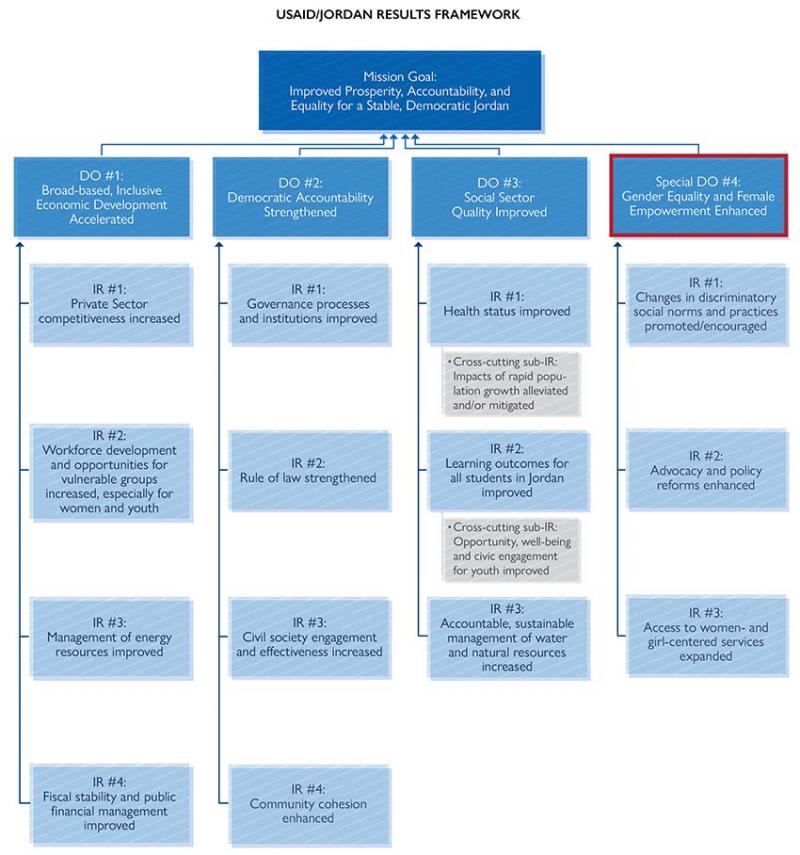6.5. Establish WEEGE-Specific DOs, IRs and/or Sub-IRs
The next step in the WEEGE MEL process creates DOs that speak to and address the ToC. The DOs at the CDCS or RDCS level also will inform how project- and activity-level IRs, sub-IRs and indicators are selected, so it is important to dedicate time to determine what the DOs will seek to measure. The DOs should address the goals and ToC put forward by the Mission and provide clarity around how it intends to achieve those goals. The results framework from the previous 2013-2017 Jordan CDCS shows that the fourth DO will focus on gender, specifically on issues important to WEEGE.USAID/Jordan recently released a 2020-2025 CDCS which can be found at https://www.usaid.gov/sites/default/files/documents/CDCS-Jordan-2020-2025.pdf
DO 4 states: “Gender equality and female empowerment enhanced.” This DO emphasizes two key concepts in WEEGE: gender equality and female empowerment. While, as discussed previously, these are difficult concepts to define and measure, by creating a DO that seeks to do just that, USAID Jordan is indicating its commitment to addressing two of the core definitional elements of WEEGE. This commitment is codified by the DO, which, in turn, will require PMP and MEL plans at all levels to address this DO.
To ensure that WEEGE is integrated into both programming decisions and MEL planning throughout the program cycle, have at least one DO that specifically addresses WEEGE, or integrate WEEGE into all DOs. To do so, develop a WEEGE-centered ToC or Mission goal that will guide decision-making on these issues.
Image

Image originally appeared in the 2013-2017 USAID/Jordan CDCS document (https://www.usaid.gov/sites/default/files/documents/1883/Amended-Jordan-Country-Development-Strategy-March-2015.pdf).
Integrating WEEGE, does not stop at the DO level. As illustrated in the Jordan example, it is important to drill down into the IRs and sub-IRs to integrate WEEGE. IRs are meant to further explain and elucidate what USAID is trying to achieve, providing more specific information about what USAID programming will measure. For example, in the Jordan results framework, under DO 4, IR 3 is “access to women- and girl-centered services expanded.” By establishing this IR, USAID Jordan has shown that programming at every level—CDCS, project and activity—needs to support that IR, and planning must be done accordingly. However, though IR 3 may affect WEEGE, it is not WEEGE-specific. A WEEGE-specific IR might be (for example) “women’s access to business financing expanded.” Ensuring that WEEGE work is implemented as a result of IR 3 will require additional planning.
The IRs a Mission selects (at the CDCS or RDCS level) shape all levels of MEL planning. Projects and activities are products of the planning done at the CDCS level; therefore, incorporating WEEGE at the CDCS level is crucial to ensuring these concepts remain integral at the other levels. Creating WEEGE-related DOs and IRs at the CDCS or RDCS level, as Jordan has done, will ensure that project and activity MEL planning and programming will measure WEEGE and potential outcomes. For additional discussion around WEEGE in results frameworks, select this link to read Unit 3, Sample 2: Integrating WEEGE into a Results Framework.
If WEEGE is not integrated at the DO level, several options exist to ensure WEEGE MEL is integrated into planning frameworks: through WEEGE-specific IRs or sub-IRs; by selecting WEEGE indicators; or by modifying existing PMPs or MEL plans.

